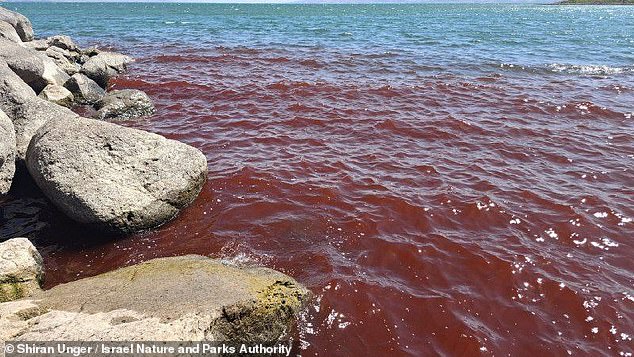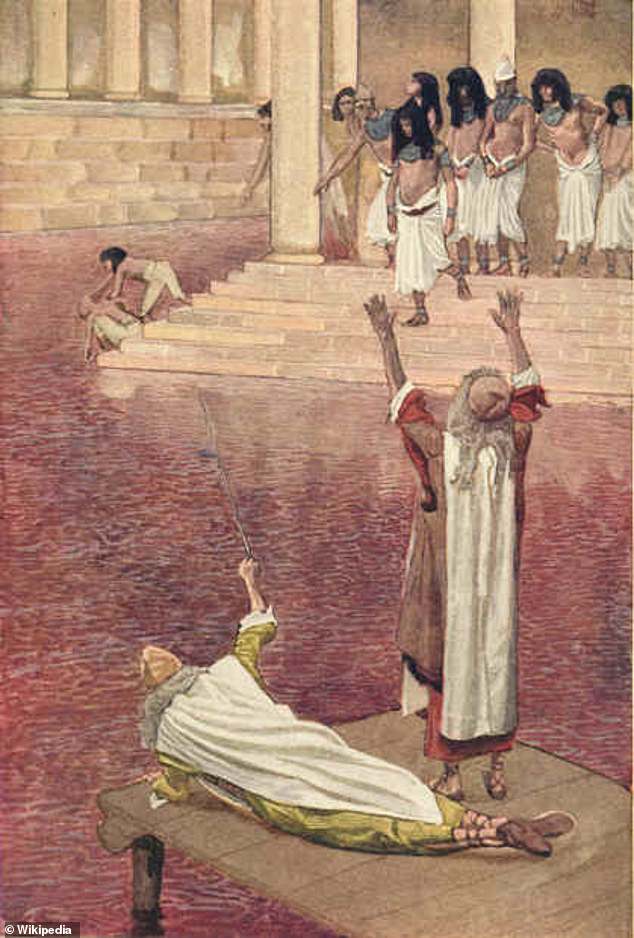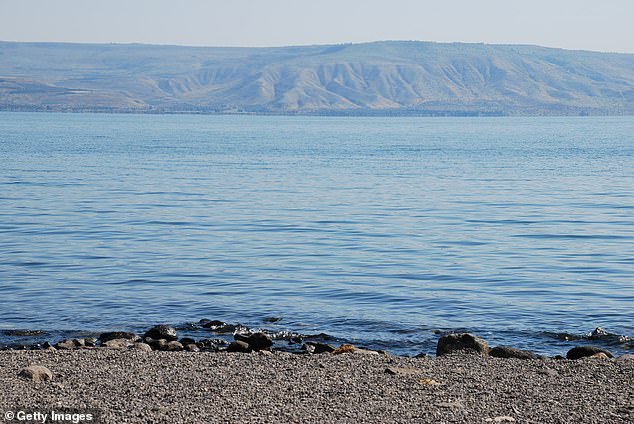By STACY LIBERATORE, U.S. SCIENCE & TECHNOLOGY EDITOR
The biblical Sea of Galilee has mysteriously turned a vivid blood-red, leaving locals rattled and warning of a ‘bad omen.’
Stunned visitors watched crimson waves roll onto the shore, with some comparing the eerie transformation to the Ten Plagues God inflicted on the Egyptians in the biblical narrative of Exodus.
According to scripture, the curse saw the Nile’s waters struck by Moses’ staff at God’s command, turning them to blood in a divine act of judgment.
‘Thus says the Lord: By this you shall know that I am the Lord. Behold, with the staff that is in my hand I will strike the water that is in the Nile, and it shall turn into blood,’ Exodus 7:17-21 reads.
The apocalyptic spectacle set social media ablaze, with many calling it a sign of the End Times, but scientists said there is a far less supernatural explanation.
Israel‘s environmental ministry confirmed that the transformation this month was caused by a bloom of green algae in the freshwater lake, which turns red when a natural pigment builds up under intense sunlight.
The pigment is harmless, officials stressed, and tests show the water is safe for swimming, despite its unsettling hue.
Tests by the Kinneret Research Laboratory found the algae in the affected areas are harmless, with no health risks or allergic reactions reported among those exposed.

The Sea of Galilee in Israel mysteriously turned red this month, sparking fears of biblical omens. However, officials confirmed a bloom of green algae turned the waters red
The discoloration was caused by Botryococcus braunii, which is found in various aquatic environments like freshwater and brackish water bodies worldwide.
It’s a green microalga known for producing significant amounts of hydrocarbons, which are similar to crude petroleum and can be used for biofuel production.
The phenomenon is caused by a natural buildup of pigments from certain algae, likely due to a bloom of microscopic organisms like cyanobacteria or dinoflagellates.
These organisms produce vivid red colors when conditions such as warm temperatures, nutrient-rich waters and sunlight are present.
While natural, the red waters have deep symbolic resonance for many Christians and Jewish communities, given the lake’s biblical significance.
In the New Testament, the Sea of Galilee was the setting for many of Jesus’ miracles, including walking on water and the miraculous catch of fish.
It was also where he fed five thousand people with a few loaves and fish and called Peter, Andrew, James, and John to be his disciples.

The Book of Exodus describes the Ten Plagues of God. The first the curse saw the Nile’s waters struck by Moses’ staff at God’s command, turning them to blood in a divine act of judgment

The Sea of Galilee, also called Lake Tiberias, Genezareth Lake or Kinneret, is a freshwater lake in Israel.
In 2021, a pool of water located close to the Dead Sea in the biblical region of Moab, modern-day Jordan, mysteriously turned blood red.
The blood-red pond is located along the eastern shores of the Dead Sea, an area believed to be the site of the legendary cities of Sodom and Gomorrah, which, according to scripture, were destroyed by God for their wickedness.
The images also sparked a furor on social media, with blood red waters carrying much significance in the Old Testament as one of the 10 plagues God cast upon the Pharaoh of Egypt to free the Jews from slavery.
The Bible recounts that God sent ten plagues upon Egypt to persuade Pharaoh to free the Israelites from slavery.
The first plague turned the Nile to blood, killing fish and poisoning the water, said to have occurred when Moses struck the Nile with his staff.
Following the first plague, Egypt was struck by swarms of frogs, lice or gnats, and flies, along with deadly livestock disease and painful boils.
A severe hailstorm, locust swarms, three days of thick darkness, and finally the death of every firstborn son forced Pharaoh to release the Israelites.
The region around the Sea of Galilee has seen other dramatic events, such as the high salinity of the Dead Sea.











